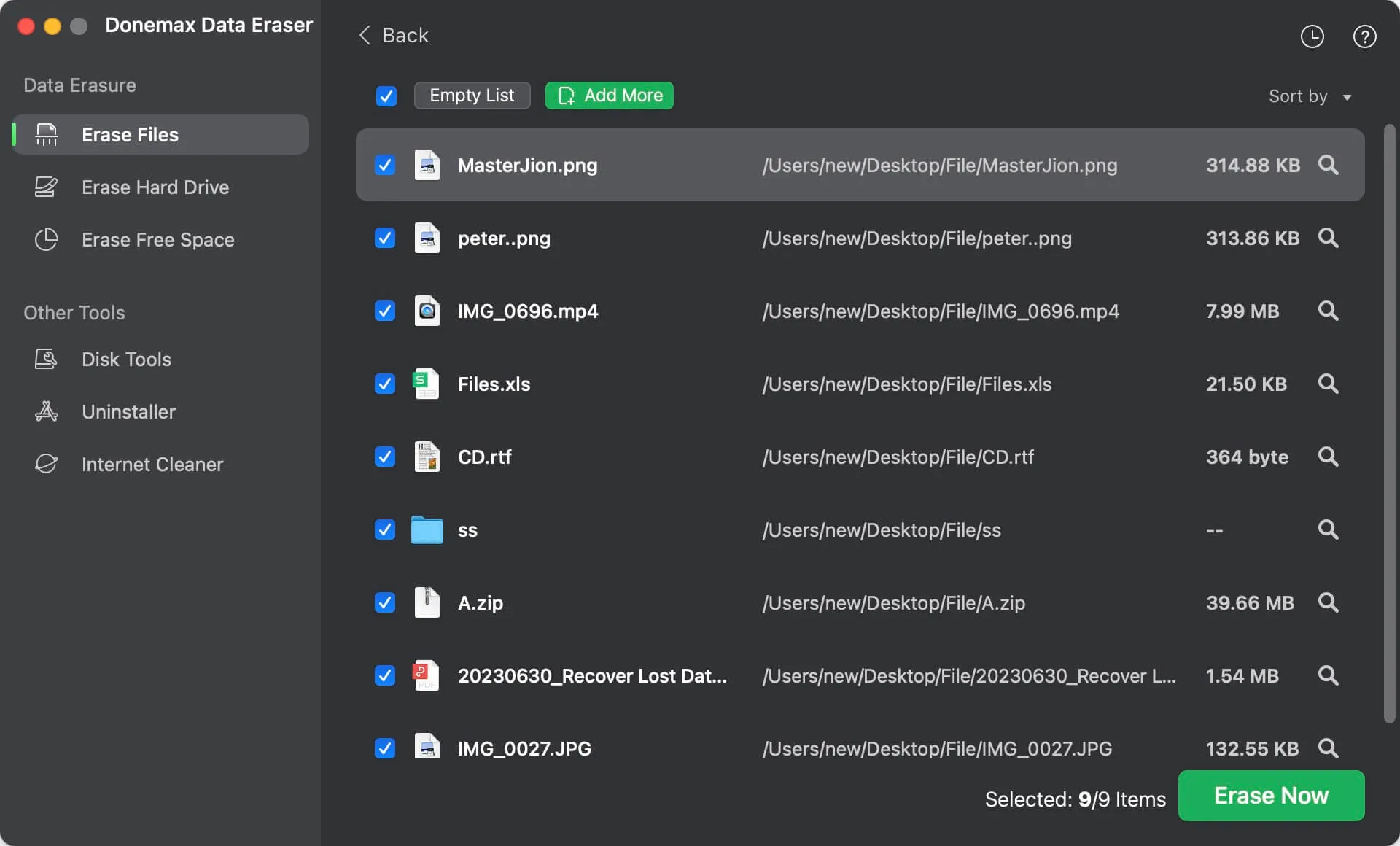Deleting files using the standard method on your computer might make you think they’re gone forever. However, these deleted files are often recoverable with the right tools. You need to use a file shredder to safeguard your digital privacy and ensure that your sensitive information is irretrievably gone. These tools apply rigorous shredding algorithms to overwrite your data multiple times, thwarting any attempts at recovery and keeping your private information secure.
File shredders are essential for maintaining privacy in an era where data breaches are common. They go beyond simple deletion to destroy data at a level where it cannot be reconstructed. Whether you’re a business owner handling client information or an individual concerned about personal data leaks, embracing file shredders is a critical step toward digital security.

Understanding Data Erasure with File Shredder Tools
File shredder tools provide a solution to the limitations of traditional file deletion methods. By utilizing advanced algorithms, these tools ensure that the data you erase is written over with random binary data. This process makes the original information unrecognizable and irrecoverable, which is crucial when you must permanently remove sensitive files from your system.
The risk of data falling into the wrong hands is a significant concern in our digital age. File shredder tools offer peace of mind by ensuring that it cannot be accessed or reconstructed once a file is shredded, even with the most sophisticated data recovery software. This is why more users are using these tools for secure data erasure. Protecting sensitive information also involves using strong credentials, which act as a first line of defense against unauthorized access, complementing the role of file shredders in maintaining privacy.
The Need for Secure Data Deletion
With the proliferation of data breaches and identity theft, it’s more important than ever to destroy data containing sensitive information permanently. This includes temporary files, which may store confidential data and can be retrieved if not properly erased. Secure data deletion is not just a precaution; it’s necessary to protect yourself from potential threats and ensure that your personal or business information remains confidential.
How File Shredders Work to Prevent Data Recovery
File shredders prevent data recovery by implementing shredding algorithms designed to overwrite files with patterns of meaningless data. This process is repeated multiple times, making it virtually impossible for data recovery software to recreate the original content. By thoroughly scrambling the data, file shredders ensure that once files are deleted, they stay deleted, upholding your digital privacy.
1. Traditional Deletion
When you delete a file on your computer, it doesn’t actually disappear. Instead, the operating system marks the space occupied by the file as available for new data. Until that space is overwritten, the original file can potentially be recovered.
2. Shredding Process
File shredders go beyond simple deletion. They overwrite the content of the file multiple times with random data, making it extremely difficult, if not impossible, to reconstruct the original information. This process is known as data wiping or secure file deletion.
3. Overwriting Data
During shredding, file shredders overwrite the file’s data with random characters or patterns. The more times this overwriting occurs, the more secure the deletion becomes. Commonly used algorithms include DoD 5220.22-M, Gutmann, and Schneier. Cloud storage services provide a convenient way to store and share files, but users should still be cautious about how their data is deleted from these platforms. Without proper data removal techniques, information may remain accessible even after it’s been deleted from your account.
4. Preventing Fragmented Recovery
Files are often fragmented across different sectors on a storage device. File shredders address this by overwriting the main file and the associated fragments. This ensures that no traces of the original data are left scattered on the storage medium.
5. Types of Shredding
File shredders offer various shredding options, allowing users to choose the level of security they need. Some tools provide quick shredding for everyday use, while others offer more thorough methods for sensitive information. For those requiring an extra layer of protection, certain shredders include advanced security features such as the use of a confidential code to ensure only authorized individuals can access or operate the device. This added measure enhances the overall safety and confidentiality of your documents.

Top File Shredder Software for Comprehensive Data Erasure
When it comes to choosing file shredder software, there’s a range of options available to suit different needs. Whether you’re looking for a tool that can wipe free disk space on a Windows Server 2012 or securely erase sensitive data from your hard drive, software is designed to meet these requirements. These tools not only delete files but also ensure that the remnants of the data are unrecoverable, offering a comprehensive solution for data erasure.
Different software may offer various features, from simple one-pass overwrites to multi-level shredding processes, allowing for flexibility in the level of security provided. The top file shredder programs are built to handle a broad spectrum of storage devices, making them invaluable for anyone looking to maintain stringent data security protocols.
1. Eraser - A Reliable Data Destruction Tool
Eraser stands out as a robust data destruction tool that erases sensitive data from your hard drive and offers the option to wipe free disk space. It’s particularly useful for systems running on Windows Server 2012, as it can seamlessly integrate with the operating system to securely eliminate files. Eraser provides a user-friendly interface, making it a reliable choice for personal and business users who must ensure their data is permanently removed.
2. Hardwipe - Intense Erasing for Various Storage Devices
Hardwipe is renowned for its intense erasing capabilities, suitable for various storage devices. It employs multiple data sanitization methods, ensuring your secure data is deleted and destroyed. Hardwipe’s versatility extends to its ability to manage deleting files in batches, making it efficient for large-scale data shredding tasks. This software is a strong ally in the battle to maintain digital privacy.
3. PrivaZer - Ensuring Privacy with Thorough Cleansing
PrivaZer securely deletes files and cleans SD cards and other storage mediums with its unique data sanitization methods. It’s designed to provide an in-depth cleaning of your system, targeting traces of old files and internet activity that can compromise your privacy. PrivaZer’s comprehensive approach to privacy maintenance makes it a valuable tool for those who take their data security seriously.
4. Moo0 File Shredder - Simple Yet Effective Data Shredding
Moo0 File Shredder offers a straightforward solution for users who need to shred multiple files quickly. With instant access and a simple drag-and-drop interface, this file shredder program enables users to easily select and destroy files. Its simplicity does not compromise its effectiveness, making Moo0 a practical choice for everyday data shredding needs.
5. PC Shredder - A User-Friendly Approach to Data Security
PC Shredder’s user-friendly interface makes it easy to securely delete a single file or a batch of files with minimal effort. It’s a portable tool that can be carried on a USB flash drive, allowing you to maintain data security no matter where you are. Despite its simplicity, PC Shredder uses powerful deletion methods to ensure that your files are permanently erased.
Exploring Free File Shredder Alternatives
For those reluctant to invest in paid software, free file shredder alternatives can effectively erase data and shred sensitive files. While some may employ the Gutmann method or other comprehensive shredding algorithms, it’s important to understand that these free tools also come with limitations. Nonetheless, they offer a viable option for individuals and organizations looking to protect their information without incurring additional costs.
Advantages and Limitations of Free Shredding Solutions
Free shredding solutions can be attractive for their zero-cost advantage, providing essential services to erase existing data. However, users must know that these free versions may lack advanced features or support, which can be crucial for certain data security needs. While effective for basic use, they may not meet the stringent requirements for high-security environments.
Deleting Shredding: What’s the Difference?
The distinction between deleting and shredding is crucial regarding data security. Deleting files typically removes them from the directory structure, making them invisible to users but not necessarily gone. Shredding, on the other hand, involves overwriting the data multiple times, ensuring that the files are not just hidden but completely destroyed and unrecoverable.
Key Features in Free File Shredders
Key features to look for in free file shredders include multiple overwrites of files, compatibility with various storage devices, and ease of use with a clean interface. Some may offer right-click context menu integration for quick access, and others might provide different shredding levels depending on the files’ sensitivity.
Best Practices for Erasing Data with File Shredders
Using file shredders to erase files and folders is not just about running the software; it’s about following best practices to ensure complete data security. Implementing regular shredding schedules, using multi-pass shredding for advanced data destruction, and understanding the certifications and standards for data erasure are all critical components. Additionally, these practices become even more important when dealing with various storage devices, from USB flash drives to large disk management systems.
To maintain the highest data security standards, it’s advisable to use reputable disk wiping tools like Blancco File Eraser, which offers permanent erasure certified by globally recognized methods. Whether you’re operating on Windows Server 2008 or the latest version of a personal operating system, the goal remains the same: to ensure that once deleted data is gone, it cannot be retrieved by any data recovery software, guaranteeing that file deletion truly means the data is unrecoverable.
Regularly Scheduled Data Destruction
To maintain optimal data security, it’s crucial to incorporate regularly scheduled data destruction into your routine. Setting up a schedule to launch the program and shred sensitive files ensures that information no longer needed is not left vulnerable to unauthorized recovery. This practice protects your privacy and helps adhere to data protection regulations that may apply to your personal or business data.
Multi-Pass Shredding for Enhanced Security
Multi-pass shredding is a method where file shredder tools overwrite data multiple times with random binary data, enhancing the security of data erasure. This process makes it exceedingly difficult for file recovery software to retrieve any meaningful information. Using a multi-pass approach adds an extra layer of protection, ensuring that your deleted files remain inaccessible and permanently erased from your hard drive.
Understanding Data Erasure Certifications and Standards
Understanding the various certifications and standards for data erasure is crucial for ensuring compliance with regulatory requirements. These standards dictate the procedures and levels of security necessary for effective data destruction. By selecting certified file shredder tools that adhere to these stringent protocols, you can trust that your data is being handled according to the highest industry benchmarks, guaranteeing a tamper-proof audit trail and alignment with global data security practices.
Conclusion
To ensure your digital privacy, it is essential to delete files in a manner that renders the scope of recovery non-existent. Utilizing tools such as BitRaser File Eraser can make files impossible to recover, securing sensitive data beyond the capabilities of standard deletion processes. Shredding files is not just about making space on your hard drive but protecting information from falling into the wrong hands.
Whether dealing with a single file or folder, remember that secure deletion means overwriting the data multiple times. With the standard of at least 3 passes recommended for a robust erasure, even software as old as Windows 2000 can be cleaned effectively. By being proactive in data erasure, you can maintain control over your personal information and ensure that it stays deleted once you choose to delete a file.
